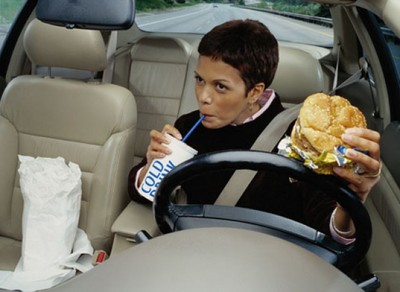Summer Travel Safety 102: Stay on Your Toes and Keep Your Eyes on the Road
 |
TORRANCE, CA -- June 17, 2015: Ah, the summer road trip…a perfect time to relax as you rock
and roll toward the family vacation. But if you’re sampling the
latest mocha offering from an omnipresent coffee chain or arguing with your
teen about whether Tame Impala is the new Beatles, driving should be you
not.
According to a 2006 study, driver inattention – from fatigue or a driving distraction -- was a contributing factor in nearly 80 percent of crashes. Nearly 80 percent. Or four out of five.
A driving distraction is anything that takes your eyes (visual) or your mind (cognitive) off the road or your hands off the wheel (manual). And some of the more dangerous distractions are a combination, such as texting, which involves all three.
But there are a lot of behaviors that distract or make us inattentive. Here are some to avoid:
Eating and drinking – Chomping down a burger on the way home from work? This seemingly innocent activity is not only a visual and manual distraction, it also happens with extreme frequency, making it more of a hazard. And according to Insurance.com, some foods are more dangerous than others.3 Top no-no consumables in the car: hot coffee and soup, tacos, chili, hamburgers, barbecued food, fried chicken and jelly donuts.
Grooming – Other not-so-innocent distractions. Save shaving for the shower and lay off putting on lipstick behind the wheel.
Talking with passengers – Restricting this behavior can be difficult, especially with inquisitive children in the vehicle. A quick tip: be sure they are properly and safely buckled up and give them books, toys or games to occupy their time.
Adjusting the radio or climate controls – Adjust vehicle controls, such as mirrors, heat or air conditioning, before you begin your trip. Take advantage of normal stops to adjust controls or ask your passenger to adjust controls.
Fatigue – Driving while drowsy results in a four- to six-times higher near-crash/crash risk. Long trips can be tough on children and you. Plan to stop along the way to take a group stretch, get something to eat and drink, return any calls or text messages, and change drivers if you’re feeling tired or drowsy.
Using a cell phone – Of course, using a cell phone remains one of the most dangerous distractions. Activities performed when completing a phone call (reaching for a phone, looking up a contact and dialing the number) increased crash risk by three times.4 Put another way, taking your eyes off the road for 5 seconds is like driving the length of an entire football field at 55 mph wearing a blindfold.
According to a 2006 study, driver inattention – from fatigue or a driving distraction -- was a contributing factor in nearly 80 percent of crashes. Nearly 80 percent. Or four out of five.
A driving distraction is anything that takes your eyes (visual) or your mind (cognitive) off the road or your hands off the wheel (manual). And some of the more dangerous distractions are a combination, such as texting, which involves all three.
But there are a lot of behaviors that distract or make us inattentive. Here are some to avoid:
Eating and drinking – Chomping down a burger on the way home from work? This seemingly innocent activity is not only a visual and manual distraction, it also happens with extreme frequency, making it more of a hazard. And according to Insurance.com, some foods are more dangerous than others.3 Top no-no consumables in the car: hot coffee and soup, tacos, chili, hamburgers, barbecued food, fried chicken and jelly donuts.
Grooming – Other not-so-innocent distractions. Save shaving for the shower and lay off putting on lipstick behind the wheel.
Talking with passengers – Restricting this behavior can be difficult, especially with inquisitive children in the vehicle. A quick tip: be sure they are properly and safely buckled up and give them books, toys or games to occupy their time.
Adjusting the radio or climate controls – Adjust vehicle controls, such as mirrors, heat or air conditioning, before you begin your trip. Take advantage of normal stops to adjust controls or ask your passenger to adjust controls.
Fatigue – Driving while drowsy results in a four- to six-times higher near-crash/crash risk. Long trips can be tough on children and you. Plan to stop along the way to take a group stretch, get something to eat and drink, return any calls or text messages, and change drivers if you’re feeling tired or drowsy.
Using a cell phone – Of course, using a cell phone remains one of the most dangerous distractions. Activities performed when completing a phone call (reaching for a phone, looking up a contact and dialing the number) increased crash risk by three times.4 Put another way, taking your eyes off the road for 5 seconds is like driving the length of an entire football field at 55 mph wearing a blindfold.


